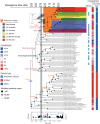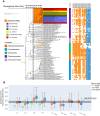Phylogenomic Evidence for the Origin of Obligate Anaerobic Anammox Bacteria Around the Great Oxidation Event
- PMID: 35920138
- PMCID: PMC9387917
- DOI: 10.1093/molbev/msac170
Phylogenomic Evidence for the Origin of Obligate Anaerobic Anammox Bacteria Around the Great Oxidation Event
Abstract
The anaerobic ammonium oxidation (anammox) bacteria can transform ammonium and nitrite to dinitrogen gas, and this obligate anaerobic process accounts for up to half of the global nitrogen loss in surface environments. Yet its origin and evolution, which may give important insights into the biogeochemistry of early Earth, remain enigmatic. Here, we performed a comprehensive phylogenomic and molecular clock analysis of anammox bacteria within the phylum Planctomycetes. After accommodating the uncertainties and factors influencing time estimates, which include implementing both a traditional cyanobacteria-based and a recently developed mitochondria-based molecular dating approach, we estimated a consistent origin of anammox bacteria at early Proterozoic and most likely around the so-called Great Oxidation Event (GOE; 2.32-2.5 Ga) which fundamentally changed global biogeochemical cycles. We further showed that during the origin of anammox bacteria, genes involved in oxidative stress adaptation, bioenergetics, and anammox granules formation were recruited, which might have contributed to their survival on an increasingly oxic Earth. Our findings suggest the rising levels of atmospheric oxygen, which made nitrite increasingly available, was a potential driving force for the emergence of anammox bacteria. This is one of the first studies that link the GOE to the evolution of obligate anaerobic bacteria.
Keywords: anammox bacteria; molecular dating analysis; planctomycetes.
© The Author(s) 2022. Published by Oxford University Press on behalf of Society for Molecular Biology and Evolution.
Figures



Similar articles
-
Metabolic Diversity and Aero-Tolerance in Anammox Bacteria from Geochemically Distinct Aquifers.mSystems. 2022 Feb 22;7(1):e0125521. doi: 10.1128/msystems.01255-21. Epub 2022 Feb 22. mSystems. 2022. PMID: 35191775 Free PMC article.
-
[Bacterial anaerobic ammonia oxidation (Anammox) in the marine nitrogen cycle--a review].Wei Sheng Wu Xue Bao. 2009 Mar;49(3):281-6. Wei Sheng Wu Xue Bao. 2009. PMID: 19623949 Review. Chinese.
-
Anaerobic ammonium oxidation by anammox bacteria in the Black Sea.Nature. 2003 Apr 10;422(6932):608-11. doi: 10.1038/nature01472. Nature. 2003. PMID: 12686999
-
Anammox bacteria disguised as denitrifiers: nitrate reduction to dinitrogen gas via nitrite and ammonium.Environ Microbiol. 2007 Mar;9(3):635-42. doi: 10.1111/j.1462-2920.2006.01183.x. Environ Microbiol. 2007. PMID: 17298364
-
The anammoxosome: an intracytoplasmic compartment in anammox bacteria.FEMS Microbiol Lett. 2004 Apr 1;233(1):7-13. doi: 10.1016/j.femsle.2004.01.044. FEMS Microbiol Lett. 2004. PMID: 15098544 Review.
Cited by
-
Age, metabolisms, and potential origin of dominant anammox bacteria in the global oxygen-deficient zones.ISME Commun. 2024 Apr 22;4(1):ycae060. doi: 10.1093/ismeco/ycae060. eCollection 2024 Jan. ISME Commun. 2024. PMID: 38770059 Free PMC article.
-
Distinct microbial nitrogen cycling processes in the deepest part of the ocean.mSystems. 2024 Jul 23;9(7):e0024324. doi: 10.1128/msystems.00243-24. Epub 2024 Jun 28. mSystems. 2024. PMID: 38940525 Free PMC article.
-
Dating Ammonia-Oxidizing Bacteria with Abundant Eukaryotic Fossils.Mol Biol Evol. 2024 May 3;41(5):msae096. doi: 10.1093/molbev/msae096. Mol Biol Evol. 2024. PMID: 38776415 Free PMC article.
-
Nitrite accumulation and anammox bacterial niche partitioning in Arctic Mid-Ocean Ridge sediments.ISME Commun. 2023 Mar 29;3(1):26. doi: 10.1038/s43705-023-00230-y. ISME Commun. 2023. PMID: 36991114 Free PMC article.
-
Oxygenation of Earth's atmosphere induced metabolic and ecologic transformations recorded in the Lomagundi-Jatuli carbon isotopic excursion.Appl Environ Microbiol. 2024 Jun 18;90(6):e0009324. doi: 10.1128/aem.00093-24. Epub 2024 May 31. Appl Environ Microbiol. 2024. PMID: 38819147 Free PMC article.
References
-
- Ader M, Sansjofre P, Halverson GP, Busigny V, Trindade RIF, Kunzmann M, Nogueira ACR. 2014. Ocean redox structure across the Late Neoproterozoic Oxygenation Event: a nitrogen isotope perspective. Earth Planet Sci Lett. 396:1–13.
-
- Ader M, Thomazo C, Sansjofre P, Busigny V, Papineau D, Laffont R, Cartigny P, Halverson GP. 2016. Interpretation of the nitrogen isotopic composition of Precambrian sedimentary rocks: assumptions and perspectives. Chem Geol. 429:93–110.
-
- Anbar AD, Duan Y, Lyons TW, Arnold GL, Kendall B, Creaser RA, Kaufman AJ, Gordon GW, Scott C, Garvin J, et al. 2007. A whiff of oxygen before the Great Oxidation Event? Science 317:1903–1906. - PubMed
-
- Battistuzzi FU, Hedges SB. 2009. A Major Clade of prokaryotes with ancient adaptations to life on land. Mol Biol Evol. 26:335–343. - PubMed
Publication types
MeSH terms
Substances
LinkOut - more resources
Full Text Sources

